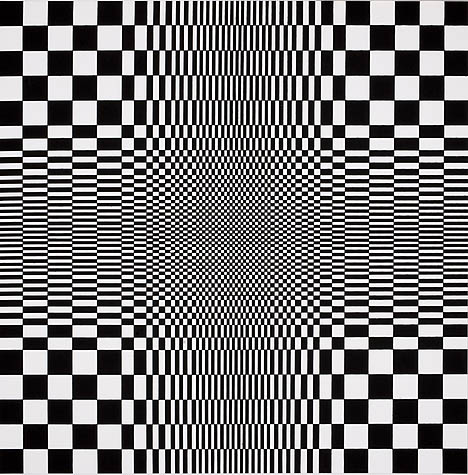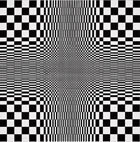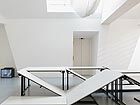
English summary November 23 - 29
Niederösterreichisches Landesmuseum: Helga Philipp – Poetry of Logic In honour of Helga Philipp The exhibition at the Landesmuseum in St. Pölten presents an extensive retrospective of the remarkable artist Helga Philipp. During the last years there weren’t many exhibitions of her work. In the 1960's, Otto Mauer displayed Philipp's art at the Gallery Nächst St. Stephan, and her work was shown in numerous other exhibitions as well as by nearly all Austrian museums and major private collections such as Herbert Liaunig's. But things became quiet around this quiet artist, who never tried to come to the fore and who no longer had a place in the art industry that was becoming increasingly louder and greedy for new trends. She devoted herself to renovating her house in Ternitz, designed by the Ringstrassen architect Theophil Hansen, which became her studio and successively her private museum. And she devoted herself to teaching at the Vienna University for Applied Arts (1965 – 2002). Among her students were Brigitte Kowanz and Alfred Graf, Heimo Zobernig and Gerwald Rockenschaub. Together with Erika Giovanna Klien and Hildegard Joos, Helga Philipp is among the small group of artists in Austria that employed an extremely strict, but at the same time exceptionally original form of artistic expression, generally known as Kinetism, Op Art, Minimal Art or Concept Art. She was concerned with the clarity of form, the beauty of abstraction, the logic of geometry and ultimately the poetry that develops when content and form meet in a spiritual way. Without conceitedness or vanity, only with the energy of artistic desire and talent. Helga Philipp would have celebrated her 70th birthday this year. She was born in 1939 and already as a 14-year old she began to study sculpting. She concentrated on space, but more with her paintings than with her sculptures. Philipps received many prizes and in the early days her work was often displayed. After a long break, her late work was shown at exhibitions: impressive the ones at the Heiligenkreuzerhof in 1997 and in Alpbach in 2000, as well as her work designed for the public sector. But her name only meant something to those who seriously dealt with contemporary art. In 2002, she retired from the university to devote herself completely to painting, which once again became colourful after years of strict black and white. She died only a few months later, in November 2002. “My concern is unaltered regarding the dialogue between the object and the onlooker. After all, it is foremost my dialogue with the object”, Helga Philipp once said. And therefore she also expects the viewer to take up the dialogue, to get involved with the artwork. It is ultimately a vital concern of art that the viewer is not only willing to permit cognition, but also to accept change. The artwork is the artist’s perception, which the viewer has to finalize with his cognizance. The extensive catalogue published for the exhibition impressively documents her career. Both the book as well as the 250 photos of the exhibition, which stem from the Lower Austrian Federal State collections, from the University of Applied Arts and from the legacy, a remarkable artist once again takes the centre stage. By Angelica Bäumer Niederösterreichisches Landesmuseum 3109 St. Pölten, Franz Schubert-Platz 5, until 24.05.10 www.landesmuseum.net Städel Museum: Botticelli. Image, Myth, Reverence Maria, Minerva, Venus – Botticelli’s fairest one of all Venus attracts the viewer’s attention in a most promising way. But if one counts on seeing the mythological painting “The Birth of Venus” next to this less known monograph one is bound to be disappointed as the painting may under no circumstances leave the Uffizi. Nonetheless, the exhibition is a “real sensation”, because it is the first monographic show of Sandro Botticelli’s work in the German-speaking region. More than 40 pieces created by the Renaissance painter (1444/45 – 1510) and 40 works of his contemporaries were compiled for “Botticelli. Image, Myth, Reverence. Before getting a good view of Venus, located in the second part of the exhibition titled “Myth”, one must pass through a room devoted to Botticelli’s portraits. Here the painting of Simonetta Vespucci (owned by the Städel), known as the ideal female image, attracts the onlooker’s attention. The portrait is not so much a close-to-life depiction but the ideal of a woman, distinguished by absolute beauty and virtue. Botticelli is well known to the broad public for his allegories. The goddess of love is disconnected from earlier Venus-depictions; detached from the narrative context of the “Birth” she is one of the first monumental nude studies of post-antique art. “Minerva and Centaur” is one of the highlights at this exhibition, the pendant to the also absent “Primavera”. The virtuous goddess of wisdom, whose melancholy features remind of Simonetta, tames the wild mixed creature, which is dominated by its appetence. Yet, not the mythological but the religious motifs constituted the major part of Botticelli’s work. A connection between the two genres is created by the physiognomy of the Madonna, which follows the same character the painter developed for his idealized portraits and antique goddesses. Maria, the ideal woman according to theological perceptions, is both the most virtuous and the most beautiful. This way the viewer can indulge in the third part of this exhibition, in reverence. Thanks to Botticelli’s innovative energy, the paintings never go beyond the border of Kitsch. Conclusion: promise fulfilled! By Lotus Brinkmann Städel Museum 60596 Frankfurt am Main, Dürerstrasse 2, until 28.02.10 www.staedelmuseum.de Grazer Kunstverein: Provisional Yoga Evolution of the utility item The deliberations regarding the current exhibition at the Grazer Kunstverein started out with Adolf Loos, Soren Grammel pointed out; Loos, who demanded clarity in dealing with concepts of space, who found strong words for formal validities and who created a slogan with “ornament and crime” (1908); a slogan, to which he is often reduced. Further deliberations concentrated on Siegfried Kracauer, who was not an architect, but who underlined the potential of ornament as a form of play. All of this resulted in the not really tangible title of the exhibit, which refers to the unpredictable within defined sequences. The invited artists deal with diverse forms of design-, furniture-, architectural or sportive elements. These underlie certain moments of misappropriation, are detached from their original context, respectively from general disassociations, something that is more or less appealing. Henning Bohl shows how a strong impact can be achieved with simple means: 16 foldable conference tables form a sculpture by being set up in different variations. Fabrics interseason designed a series of furniture with original transformations: the seat of the Stoke Tripp-Trapp highchair is fitted with Viennese netting, transforming it into a Thonet-Stoke. The room partition is made of construction fencing, the bed is upholstered with Raffia Superfine from Madagascar, and the curtain hangs limply from the ceiling instead of shielding the skylight windows. Sofie Thorsen’s “Tiere wollte ich auch nicht gestalten” (Nor did not want to design animals”) (2009) is both formally convincing and proves the artist’s extensive knowledge about architecture as well as her in-depth research regarding architectural sculpture of Viennese post-war buildings. Thorsen detaches them from their ambience and presents them in a slide show, and displays sketches that take up the structure of the façade, reduce the line, and mirror all this in a clear form. By Nora Theiss Grazer Kunstverein 8020 Graz, im Palais Thinnfeld, Mariahilferstrasse 2, until 19.12.09 www.grazerkunstverein.org Akademie der bildenden Künste: Which life? Between profession and vocation Exhibiting during a time of occupation Heated discussions - not only by protesting students of the Academy of Fine Arts in their plenary session against university reforms, but also in the smaller circle of those artists selected for the exhibition “Which life? Between profession and vocation”. Is it justifiable to participate in an exhibition in the same building in which the lecture hall is occupied by students protesting against the increasingly school-like system in the realms of higher education? Finally, the realization prevailed that one could not reject an invitation by the renowned curator Sabine Breitwieser, because if art is not exhibited it is unable to unfold its critical potential. In addition, the exhibition focuses on the already difficult relationship between the necessary structure of the studies and the free development of the students as well as the per se not definable image of a free artist. Micha Wille’s transformation of Giuseppe Pellizza da Volpedo’s monumental painting “The Fourth Estate” (“Il Quarto Stato”) is the main work at this exhibition, but she thwarts its heroic spirit of optimism by giving it the title: “Niemals!: darfst du so tief sinken, und die Bananenmilch/den Kakao durch den man dich zieht auch noch zu trinken!!!” (Never!: may you lose your face and allow people to make fun of you). The title most probably refers more to its own steadfastness within the art-market system, which, despite the financial crisis, pays homage to a star cult and the value of an artwork. With his installation “Arbeiter Eisl” (Worker Eisl), depicting his oil and acrylic stained overall, David Eisl attests that art requires a lot of work. Art as a form of self-determined work, respectively its social acceptance, is the main topic of both Nadja Athanassowa's AK (=Workers’ Chamber) FÜR SIE collection of AK magazines, which were mailed to her as long as she financed her studies with “normal” work as an employee, and Juli Fritz, who filmed herself during her study-sessions for an exam – the prerequisite for a secure income. Marlies Pöschl is more pragmatic and organized speed dating among artists and visitors at the opening of the exhibit. However, the question remains if this only offered a platform to exchange ideas or if possible means of financing were also discussed. By Werner Rodlauer Akademie der bildenden Künste 1010 Vienna, Schillerplatz 3, until 06.12.09 www.akbild.ac.at


 Teilen
Teilen





